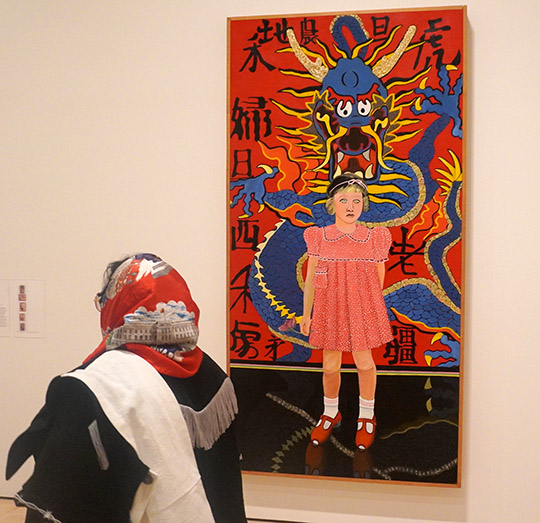A revelatory retrospective of the mostly unknown San Francisco artist Joan Brown (1938-1990) is gracing SFMOMA's top floor through early March.
Joan Brown was raised in a Catholic household in San Francisco's Marina District by an alcoholic father and a suicidal mother. In a wonderful 2011 online article by John Seed, he wrote: "Seventeen year old Joan's life pivoted when she noticed an advertisement for the California School of Fine Arts, which she decided to attend instead of the Catholic college her parents had in mind. Entering in 1955, she fell in love with the beatnik atmosphere of the school: bongo drums playing in the halls, guys with long hair, beards and sandals. Bright and charismatic, she immediately attracted male attention. "I have this extraordinary student," Elmer Bischoff told his colleague Wally Hedrick, "She's either a genius or very simple." (Pictured is Girl Standing (Girl with Red Nose, 1962.)
Her work was a precocious success that included a group show at the Whitney Museum and gallery representation in New York thanks to championing by her mentor Elmer Bischoff and painter David Park. (Pictured is Green Bowl, 1964.)
She married her first husband during art school, had it annulled like a good Catholic girl, then married sculptor Manuel Nuri with whom she had a son, Noel. The exhibit has a number of delightful expressionist style portraits of him growing up such as the 1964 Noel in the Kitchen.
Joan married her third husband, artist Gordon Cook, in 1968 and commemorated the event with the 1969 Joan + Rufus in front of S.F. Opera House. She decided to put aside her impasto expressionist style and in 1965 only worked on pieces in black-and-white. Color returned in 1968 along with a new, flat, cartoonish style that is uniquely her own.
Brown painted as many self-portraits as Frida Kahlo, another eccentric visionary whose work was ignored for decades until it became a full-blown cult. (Pictured is The Bride, 1970.)
She painted herself as a child in Chinatown...(Pictured is Portrait of a Girl, 1971.)
...as an adult with a cat face...(Pictured is Woman Wearing Mask, 1972.)
...and a admirer of Asian Art. (Pictured is The Room, Part 1, 1975.)
From all accounts, Brown was an intensely physical woman and was a serious San Francisco Bay swimmer. (Pictured is The Bicentennial Champion, 1976.)
In a dangerous Swim from Alcatraz in 1975, a large freighter came by and its wake nearly drowned two dozen swimmers, including Joan, who had to be rescued. (Pictured is After the Alcatraz Swim #3, 1976.)
Her series of paintings about the traumatic event are an exquisite mixture of calm and dark terror peering through the window. (Pictured is a detail from After the Alcatraz Swim #1, 1975.)
Brown was also a ballroom dancer...(Pictured is Dancers in a City #2, 1972.)
...whose depictions are so seductive that young people are taking selfies in front of them. (Pictured is Dancers in a City #4, 1973.)
Brown's fourth husband, Michael S. Hebel, was a San Francisco Police Department lieutenant who was interested in Eastern mysticism. The couple traveled to India in 1980 and she connected with the yogic guru Sai Sathya Baba (1926-2011), a rather dubious character who controlled a small spiritual empire with ashrams around the globe. Brown became a devotee and her painting style changed once again. (Pictured is Portrait of Mike, 1980.)
In the 1980s she began focusing on public art projects, often with tall, painted obelisks. It was during an installation at the guru's hometown village temple in Puttaparthi that a floor caved in above her and killed Joan and her two California assistants. She was 52 years old. (Pictured is Sacred Rocks on Nanda Devi, 1979.)
The three great art exhibits I have seen in San Francisco over the last year were all by 20th century American women who I had never heard of before: Alice Neel (click here), Faith Ringgold (click here), and now Joan Brown. It makes one wonder how many other neglected, modern women artists are still waiting to be discovered. (Pictured above is Harmony, 1982 and Self-Portrait in Studio, 1984.)


















2 comments:
https://minnesotastreetproject.com/exhibitions/1150-25th-st/beth-van-hoesen-punks-and-sisters
Enjoying seeing new art from women painters who precede us. A brave painter who had bewildering changes in her work (and husbands). One painting seems Steve Wibben embodied. Joan is inspiration for the creative life.
Post a Comment